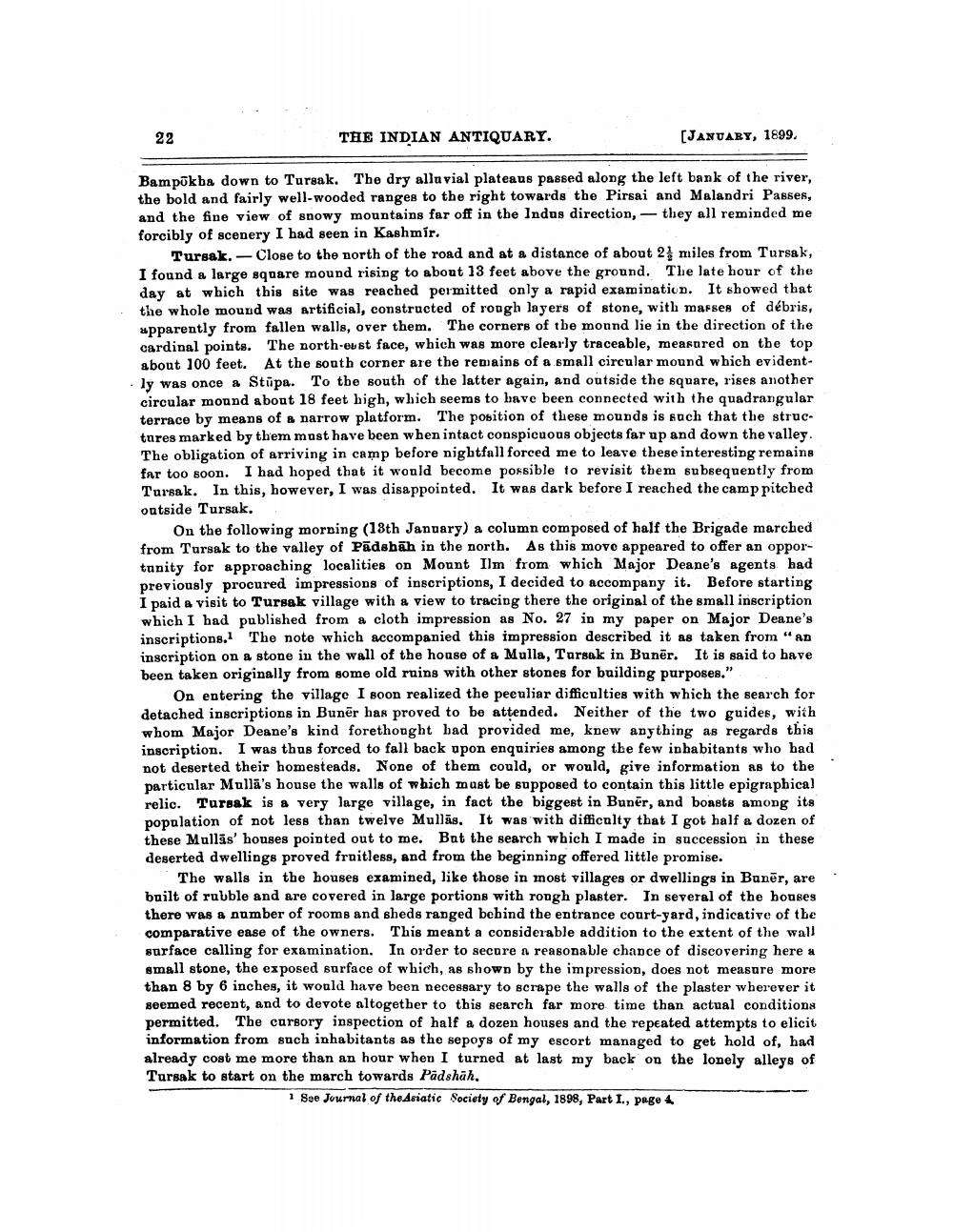________________
22
THE INDIAN ANTIQUARI.
(JANUARY, 1899.
Bampūkba down to Tursak. The dry alluvial plateaus passed along the left bank of the river, the bold and fairly well-wooded ranges to the right towards the Pirsai and Malandri Passes, and the fine view of snowy mountains far off in the Indus direction, — they all reminded me forcibly of scenery I had seen in Kashmir.
Tursak. - Close to the north of the road and at a distance of about 2 miles from Tursak, I found a large square mound rising to about 13 feet above the ground. The late hour of the day at which this site was reached permitted only a rapid examination. It showed that the whole mound was artificial, constructed of rongh layers of stone, with marses of débris, apparently from fallen walls, over them. The corners of the mound lie in the direction of the cardinal points. The north-eust face, which was more clearly traceable, measured on the top about 100 feet. At the south corner are the remains of a small circular mound which evident·ly was once a Stupa. To the south of the latter again, and outside the square, rises another
circular mound about 18 feet high, which seems to have been connected with the quadrangular terrace by means of a narrow platform. The position of these mounds is such that the structares marked by them must have been when intact conspicuous objects far up and down the valley. The obligation of arriving in camp before nightfall forced me to leave these interesting remains far too soon. I had hoped that it would become possible to revisit them subsequently from Tursak. In this, however, I was disappointed. It was dark before I reached the camp pitched outside Tursak.
On the following morning (18th January) a column composed of half the Brigade marched from Tursak to the valley of Pādsbāh in the north. As this move appeared to offer an opportanity for approaching localities on Mount Ilm from which Major Deane's agents had previously procured impressions of inscriptions, I decided to accompany it. Before starting I paid a visit to Tursak village with a view to tracing there the original of the small inscription which I had published from a cloth impression as No. 27 in my paper on Major Deane's inscriptions. The note which accompanied this impression described it as taken from "an inscription on a stone in the wall of the house of a Mulla, Tursak in Bunēr. It is said to bave been taken originally from some old ruing with other stones for building purposes."
On entering the village I soon realized the peeuliar difficulties with which the search for detached inscriptions in Bunēr has proved to be attended. Neither of the two guides, with whom Major Deane's kind forethought bad provided me, knew anything as regards this inscription. I was thus forced to fall back opon enquiries among the few inhabitants who had not deserted their homesteads. None of them could, or would, give information as to the particular Mullā's house the walls of which must be supposed to contain this little epigraphical relic. Tursak is a very large village, in fact the biggest in Buner, and boasts among its population of not less than twelve Mullās. It was with difficulty that I got half a dozen of these Mullās' houses pointed out to me. But the search which I made in succession in these deserted dwellings proved fruitless, and from the beginning offered little promise.
The walls in the houses examined, like those in most villages or dwellings in Banēr, are built of rubble and are covered in large portions with rough plaster. In several of the houses there was a number of rooms and sheds ranged bebind the entrance court-yard, indicative of the comparative ease of the owners. This meant a considerable addition to the extent of the wall surface calling for examination, In order to secure a reasonable chance of discovering here a small stone, the exposed surface of which, as shown by the impression, does not measure more than 8 by 6 inches, it would have been necessary to scrape the walls of the plaster wherever it seemed recent, and to devote altogether to this search far more time than actual conditions permitted. The cursory inspection of half a dozen houses and the repeated attempts to elicit information from such inhabitants as the sepoys of my escort managed to get hold of, had already cost me more than an hour when I turned at last my back on the lonely alleys of Tursak to start on the march towards Padshäh.
1 Soe Journal of the Asiatic Society of Bengal, 1898, Part I., Page 4




